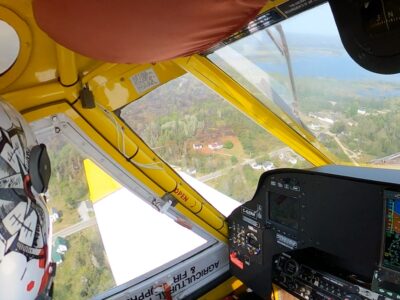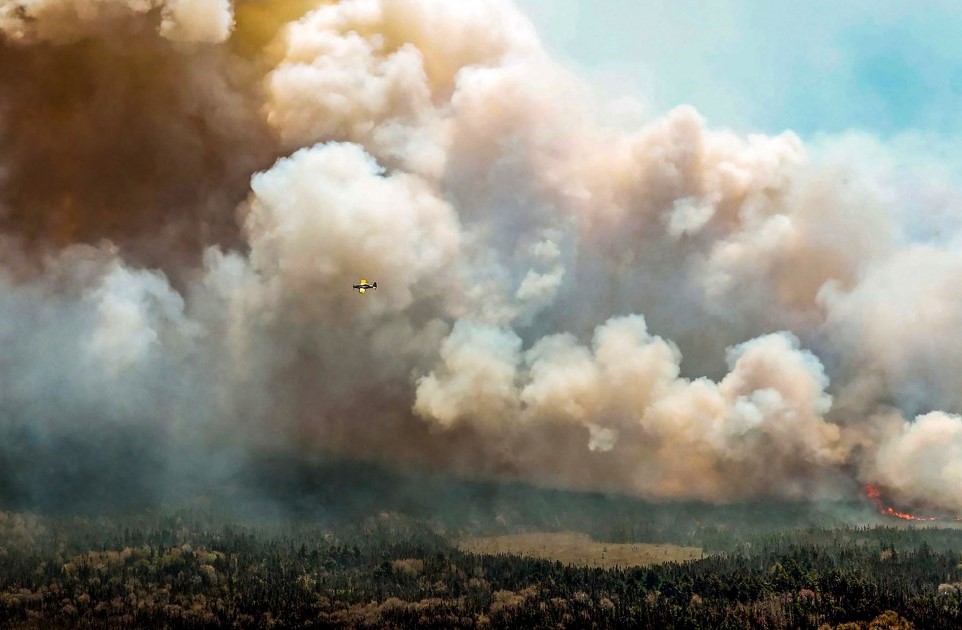Little known organization helps N.B. and its neighbours fight forest fires
Alex Graham | June 22, 2023 | Huddle.Today
FREDERICTON – May’s devastating wildfires in the Tantallon suburb of Halifax, around the southern New Brunswick tourist town of Saint Andrews and in the Barrington Lake and Pubnico areas of southeastern Nova Scotia, shone a spotlight on an often-overlooked bit of critical infrastructure: aerial forest fire fighting capabilities.
“Eleven water bombers are hitting the Barrington area, six more water bombers are on the way from Montana,” said Nova Scotia Premier Tim Houston in a June 1 update on the then out-of-control fires, which displaced a record 18,000 people, some of whom returned to destroyed homes several days later.
Some of that water bomber support came from Forest Protection Limited (FPL), a Fredericton-based non-profit corporation born out of a joint government and industry initiative to fight the spruce budworm that posed a serious threat to the health of New Brunswick’s fir and spruce forests in the 1950s.
As a part of the Canadian Interagency Forest Fire Centre, the Government of New Brunswick (GNB) provides firefighting support to Nova Scotia on an “as-needed basis,” according to provincial communications officer Nick Brown in an email exchange with Huddle.
“GNB contracts six air tankers and associated support aircraft from FPL each season,” Brown explains. “The six air tankers are broken into two teams of three and can be split to work on different fires or combined to deal with a larger fire.”
When FPL gets the call to help out, as they did with the fires in May “the Provincial Fire Fighting Centre (PFFC) dispatches FPL aerial firefighting assets within New Brunswick and other jurisdictions for aerial patrol and firefighting purposes.”
In the case of Nova Scotia, “the Air Tankers and Aerostars assisted in suppressing the Barrington wildfire,” says FPL communications manager Paisley Sibbald in an email exchange with Huddle.

VIDEO LINK: FPL creating a fire barrier in Nova Scotia.The Barrington Lake fire was deemed under control on June 13 thanks in large part to aerial firefighters who could get to the very hard-to-access parts of this rural region. The fire itself had a final size of 23,525 hectares.
FPL has eight Air Tractor AT-802 Air Tankers that can hold 3100 litres of water or fire retardant, a needed commodity in the fight against that massive, remote fire.
“In fire conditions, the AT-802 can fly up to 1000 km,” Sibbald explains. “There are 11 reload bases strategically located throughout New Brunswick, equipped with fire retardant, foam, and water.”
The Air Tankers have the capability to contain spot fires, cool hot spots, create fire retardant fire breaks and support ground firefighting efforts, Sibbald says. FPL’s firefighting fleet also has Five Aerostar Pipers, and three Cessna C208 Caravans will join the fleet in July.
“FPL fought its first wildfire in 1960 and funded aerial water-dropping experiments to perfect the best methods of aerial fire suppression over the following years,” Sibbald says. “1966 was Forest Protection’s first entire fire season.”
Putting out fires is just one part of what FPL does to protect forests from damage. Ariel surveys of zones with high potential for fire are another important part of the strategy, as well as forest management practices including pest control, which helps reduce the amount of dead, damaged and dried out trees and branches that are quick fuel for burgeoning fires.
The importance of being able to contain and control forest fires, and pest infestations, in New Brunswick’s vast forests cannot be overstated.
Forestry is the province’s largest industry, contributing $1.45 billion to the economy annually and employing over 22,000 New Brunswickers at 40 mills throughout the province.
Forests stretch from the Atlantic Ocean to the St. Croix River, the Bay of Fundy to the Baie des Chaleurs, covering 6 million of the province’s 7 million hectares, meaning forests account for 83 per cent of the entire province. Half of those forests are on Crown land.
Forest Protection Limited is majority owned by the province of New Brunswick with a 94 per cent share, with the remaining six per cent owned by forestry industry shareholders including JD Irving, Twin Rivers Paper Company, Acadian Timber, Chaleur Forest Products, and Aditya Birla AV Group.
Alex Graham is a reporter with Huddle, an Acadia Broadcasting content partner.

